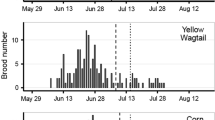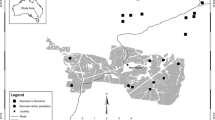Abstract
Agri-environment schemes usually assume that suitable management in patches of grassland habitat may benefit bird populations in improving the overall demographic balance. In this study, we investigate the hypothesis that nesting site fidelity after previous breeding success might lead meadow birds to select late mown fields where the risk of breeding failure is lower. It was carried out in 4 study areas of the Mézenc volcanic massif (south-east of France) within the altitude range 1,150–1,350 m. Meadow passerine territories were defined by the territory mapping method, and reproductive success in Whinchat Saxicola rubetra territories was assessed by the observation of prey carrying and juveniles just leaving nests. A comparison of models led us to consider that territorial birds selected hay fields under the influence of grass structure rather than through a theoretical successful experience of late mowing. Higher territory density was observed in fields with dense grass cover ≥50 cm which were usually more fertilized (>75 kg ha −1 nitrogen per year) and mown earlier. In 3 study sites, however, the rate of nesting failure due to mowing was lower than expected under the hypothesis of randomly distributed nesting sites, suggesting that the risk was not ignored by territorial birds. Within each study site, we also observed higher invertebrate abundance during the chick feeding period in fields with high bird territory density.
Zusammenfassung
Wählen Singvögel des Offenlandes aufgrund von erhöhtem Bruterfolg spät gemähte Felder?
Agrar-Umweltprogramme gehen normalerweise von der Annahme aus, dass Vogelpopulationen von geeigneten Managementmaßnahmen auf fleckenarteigen Teilflächen des Graslands profitieren könnten, weil durch sie die demographische Bilanz insgesamt verbessert würde. In der vorliegenden Studie bearbeiten wir die Hypothese, dass Nestortstreue nach vorherigem Bruterfolg Wiesenbrüter dazu führt, spät gemähte Felder auszuwählen, auf denen das Brutverlust-Risiko geringer ist. Die Studie wurde auf vier Teilflächen des Mézenc Vulkanmassivs (Südost-Frankreich) in Höhenlagen von 1,150–1,350 m durchgeführt. Die Brutreviere von wiesenbrütenden Singvögeln wurden mit Hilfe einer Revierkartierungsmethode erfasst, und der Reproduktionserfolg in Revieren des Braunkehlchens Saxicola rubetra durch Beobachtung Futter tragender Altvögel und gerade flügger Jungvögel bestimmt. Ein Vergleich von Modellen führte uns zu dem Schluss, dass territoriale Vögel Wiesen für die Heuernte eher unter dem Einfluss der Vegetationsstruktur auswählten, als unter dem Aspekt einer theoretisch erfolgreichen Bruterfahrung durch späte Mahd. Eine höhere Revierdichte konnte vor allem in Feldern mit dichter Grasbedeckung ≥50 cm beobachtet werden, die normalerweise besser gedüngt waren (>75 kg ha−1 Stickstoff pro Jahr) und früher gemäht wurden. In drei Untersuchungsflächen war die Brutverlustrate durch Mähen allerdings niedriger, als unter der Annahme einer zufälligen Verteilung der Neststandorte, was auf eine Berücksichtigung dieses Risikos seitens der Reviervögel hinweist. Innerhalb jeder Untersuchungsfläche beobachteten wir auf Feldern mit einer höheren Brutrevierdichte im Zeitraum der Jungenaufzucht auch eine höhere Abundanz an Evertebraten.





Similar content being viewed by others
References
Abrahams MV (1986) Patch choice under perceptual constraints: a cause for departures from an ideal free distribution. Behav Ecol Sociobiol 19:409–415
Berendse F, Chamberlain D, Kleijn D, Schekkerman H (2004) Declining biodiversity in agricultural landscapes and the effectiveness of agri-environment schemes. Ambio 33:499–502
Blackmer AL, Ackerlan JT, Nevitt GA (2004) Effects of investigator disturbance on hatching success and nest-site fidelity in a long-lived seabird, Leach’s storm petrel. Biol Conserv 116:141–148
Broyer J (2009) Whinchat Saxicola rubetra reproductive success according to hay cutting schedule and meadow passerine density in alluvial and upland meadows in France. J Nat Conserv 17:160–167
Burnham KP, Anderson DR (2002) Model selection and multimodal inference: a practical information—theoretical approach, 2nd edn. Springer, New York
Catlin DH, Rosenberg DK, Haley KL (2005) The effect of nesting success and mate fidelity on breeding dispersal in burrowing owls. Can J Zool 83:1574–1580
Cody ML (1985) An introduction to habitat selection in birds. In: Cody ML (ed) Habitat selection in birds. Academic, London, pp 3–56
Davis SK (2005) Nest site selection patterns and the influence of vegetation on nest site survival of mixed-grass prairie passerines. Condor 107:605–616
Donald PF, Evans AD, Muirhead LB, Buckingham DL, Kirby WB, Schmitt SIA (2000) Survival rates, causes of failure and productivity of Skylark Alauda arvensis nests on lowland farmland. Ibis 144:652–664
Evans AD, Green RE (2007) An example of a two-tiered agri-environment scheme designed to deliver effectively the ecological requirements of both localised and widespread bird species in England. J Ornithol 148:279–286
Fisher RJ, Davis SK (2010) From Wiens to Robel: a review of Grassland-Bird habitat selection. J Wildl Manag 74:265–273
Fletcher RJ, Koford RR (2002) Habitat and landscape associations of breeding birds in native and restored grasslands. J Wildl Manag 66:1011–1022
Fowler AC (2005) Fine scale spatial structuring in cackling Canada geese related to reproductive performance and breeding philopatry. Anim Behav 59:973–981
Frawley BJ, Best LB (1991) Effects of mowing on breeding bird abundance and species composition in Alfalfa fields. Wildl Soc Bull 19:135–142
Gauthier G (1990) Philopatry, nest-site fidelity and reproductive performance in Buffleheads. Auk 107:126–132
Gavin TA, Bollinger EK (1988) Reproductive correlates of breeding site fidelity in bobolinks (Dolichonyx oryzirorus). Ecology 69:96–103
Groen NM (1993) Breeding site tenacity and natal philopatry in the black-tailed godwit Limosa l. limosa. Ardea 81:107–113
Haas CA (1998) Effects of prior nesting success on site fidelity and breeding dispersal: approach. Auk 115:926–936
Jackober H, Stauber W (1989) Is red-backed shrike’s fidelity to territory influenced by breeding success and age? Vogelwarte 35:32–36 (in German)
Jones SL, Dieni JS, Green MT, Gouse PJ (2007) Annual return rates of breeding grassland songbirds. Wilson J Ornithol 119:89–94
Kirsch EM, Gray BR, Fox TJ, Thogmartin WE (2007) Breeding bird territory placement in riparian wet meadows in relation to invasive reed canary grass, Phalaris arundinacea. Wetlands 27:655–664
Krebs JR, Inman AJ (1992) Learning and foraging: individuals, groups and populations. Am Nat 140:63–64
Manuel F, Beaud P (1982) L’installation de silos à herbe et ses répercussions sur un échantillonnage de Traquets tariers Saxicola rubetra, nicheurs au pays d’Enhaut. Nos oiseaux 36:277–281 (in French)
Műller M, Spaar R, Schifferli L (2005) Effects of changes in farming subalpine meadows on a grassland bird, the Whinchat (Saxicola rubetra). J Ornithol 146:14–23
Nocera JJ, Forbes G, Milton GR (2007) Habitat relationship of three grassland bird species: broadscale comparisons and hayfield management implications. Avian Conserv Ecol 2:7–25
Norris CA (1945) Summary of a report on the distribution and status of the corncrake. Br Birds 38:162–168
Orians GH, Wittenberger JF (1991) Spatial and temporal scales in habitat selection. Am Nat 137:29–49
Orlowski G (2004) Abandoned cropland as a habitat of the Whinchat Saxicola rubetra in SW Poland. Acta Ornithol 39:59–66
Pough RH (1950) Comment faire un recensement d’oiseaux nicheurs. Terre Vie 97:207–213
Pőysä H, Elmberg J, Sjőberg K, Nummi P (2000) Nesting mallards (Anas platyrhynchos) forecast brood-stage food limitation when selecting habitat: experimental evidence. Oecologia 122:582–586
R Development Core Team (2009) R: a language and environment for statistical computing. R Foundation for statistical computing, from http://www.Rproject.org
Robert JC (1992) Le piège entomologique composite (PEC): une technique d’échantillonnage à large spectre de l’entomofaune terrestre circulante. Bull Soc Entomol Suisse 65:395–411 (in French)
Schmidt KA (2004) Site fidelity in temporally correlated environments enhances population persistence. Ecol Lett 7:176–184
Shields WM (1984) Factors affecting nest and site fidelity in Adirondack born swallows (Hirundo rustica). Auk 101:781–789
Simek J (2001) Pattern and breeding fidelity in the red-backed shrike (Lanius collurio). Orn Fenn 78:61–71
Söderström B, Pärt T, Linnarsson E (2001) Grazing effects on between-year variation of farmland bird communities. Ecol Appl 11:1141–1150
Stewart KEJ, Bourn NAD, Thomas JA (2001) An evaluation of three quick methods commonly used to assess sward height in ecology. J Appl Ecol 38:1148–1154
Switzer PV (1993) Site fidelity in predictable and unpredictable habitat. Evol Ecol 7:533–555
Thompson PS, Baines D, Coulson JC, Longrigg G (1994) Age at first breeding, philopatry and breeding site-fidelity in the lapwing Vanellus vanellus. Ibis 136:474–484
Tryjanowski P, Golawski A, Kuzniaks S, Mokwa T, Antczak M (2007) Disperse or stay? Exceptionally high breeding site infidelity in the red-backed shrike Lanius collurio. Ardea 95:316–320
Van den Brink V, Schroeder J, Both C, Lourenço PM, Hooijmeijer JCEW, Piersma T (2008) Space use by black-tailed godwits Limosa limosa limosa during settlement at a new nest location. Bird Study 55:188–193
Vandenberghe C, Prior G, Littlewood NA, Brooker R, Pakeman R (2009) Influence of livestock grazing on Meadow Pipit foraging behaviour in upland grassland. Basic Appl Ecol 10:662–670
Vergara P, Aguirre JI, Fargallo JA, Davila JA (2006) Nest-site fidelity and breeding success in white stork Ciconia ciconia. Ibis 148:672–677
Warren KA, Anderson JT (2005) Grassland songbird nest-site selection and response to mowing in West Virginia. Wildl Soc Bull 33:285–292
Weatherhead PJ, Forbes MRL (1994) Natal philopatry in passerine birds: genetic or ecological influences? Behav Ecol 5:426–433
Winter M, Faaborg J (1999) Patterns of area sensitivity in grassland-nesting birds. Conserv Biol 13:1424–1436
Wittenberger JF (1980) Vegetation structure, food supply and polygyny in bobolinks (Dolichonyx oryzivorus). Ecology 61:140–150
Acknowledgments
The authors thank J. Metral, T. Chanéac, P. Robert, O. Tessier for their help in the field program, J.C. Robert and F. Mora who provided the traps for invertebrate sampling, the farmers for the information on hay field management, and C. Carter for improving the English language of the manuscript.
Author information
Authors and Affiliations
Corresponding author
Additional information
Communicated by F. Bairlein.
Rights and permissions
About this article
Cite this article
Broyer, J., Curtet, L. & Boissenin, M. Does breeding success lead meadow passerines to select late mown fields?. J Ornithol 153, 817–823 (2012). https://doi.org/10.1007/s10336-011-0799-6
Received:
Revised:
Accepted:
Published:
Issue Date:
DOI: https://doi.org/10.1007/s10336-011-0799-6




